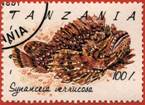
|
Adaptation |
|
Reef Stonefish have developed a number of adaptations to aid them in survival. First of all Reef Stonefish are remarkable at hiding themselves in reef bottoms, next to and under rocks and sandy or muddy bottoms. Their skin exhibits wart like surface aiding the Reef Stonefish to disguise its self as a rock or a potential reef. Another adaptation is the dorsal fin, which contains 13 spines that have the ability to inject venom into any potentially dangerous predators. The pectoral fins have also been adapted not only for swimming but also to move around on the sediment, and to aid in burring itself in the sand and mud. |

|
Reef Stonefish Synanceia verrucosa |
|
About the venom |
|
There are many poisonous fish in the sea, but Reef Stonefish is believed to be the most poisonous one. There are two criteria in which poison is categorized. First is the human mortality from the use of one ounce of the venom. And the second is the time it takes for the human to die after coming in contact with the venom.
There are three species of stonefish in the genus Synanceia, Synanceia trachynis, Synanceia horrida and Synanceia verrucosa. For the production of antivenom S. trachynis is used, and the antivenom works for all the species venom. Out of all the poisonous fishes in the sea, stonefish has to most complex and evolved venom. The venom has myotoxic, cardiotoxic, neurotoxic and vascularleakage effects on animals. For the humans however, same results have not been recorded. Instead when humans come in contact with S. verrucosa venom, the following reactions can occur.
¨ Immediate severe pain which moves throughout the body ¨ Swelling ¨ Sweating ¨ Nausea ¨ Hypotension ¨ Possible shock and paralysis ¨ Death of tissues ¨ Possible death
The venom is composed of 13% protein and 2% nitrogen. Only 18mg of venom is enough to cause death, and the 18mg can be released by only six spines. Each spine however can contain somewhere around 10mg of venom depending on the species. In the Reef Stonefish, the lethal factor is the verrucotoxin protein. Each species of the Synanceia genus has a slightly different lethal protein. All the proteins are roughly 96% similar.
|
|
Treatment |
|
After getting in contact with the Reef Stonefish to minimize the excruciating pain as much as possible immediately submerge or bathe the wound with hot water or as hot as tolerable. The hot water degenerates the active proteins in the toxin, and releaves some of the pain. As soon as possible seek medical attention to administer antivenom. |